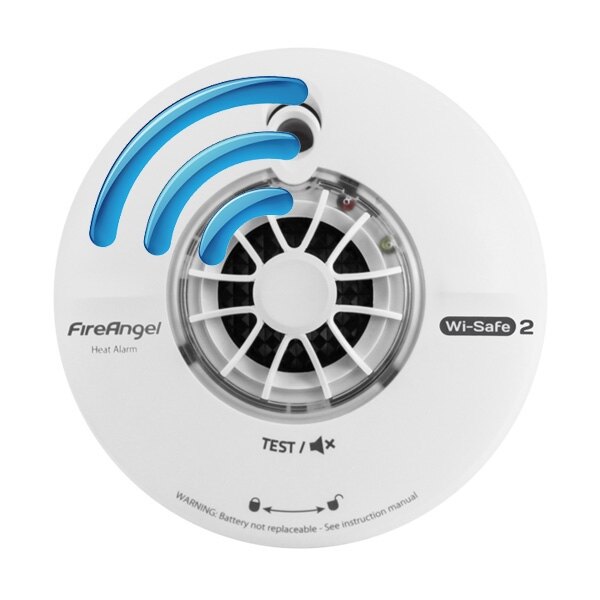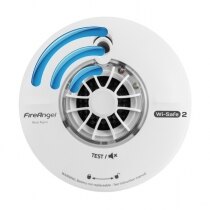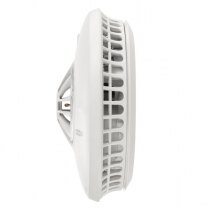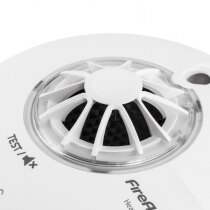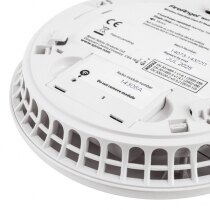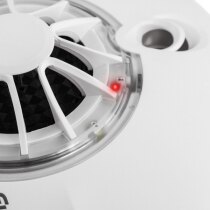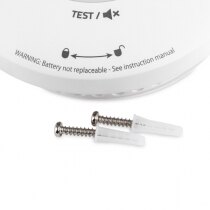Fire & Safety Solutions
CALL OUR TEAM NOW 0800 612 6537
Also FREE from UK mobiles
FREE Delivery
on this product
Secure Payments
with our fast checkout
Online Support
Contact Us Now
30 Day Accounts
for Public Sector
5 Star Customer Feedback
Radio-Interlinked Heat Alarm - FireAngel WHT637
Discontinued Product
This product has been discontinued.
alternative product
Radio-Interlinked Battery Powered Heat Alarm - UltraFire UBH1RF
- Battery: AA alkaline batteries (included)
- Warranty: 10 year warranty
- Large test and hush button
- Wireless interlink up to 50 compatible alarms
- Range of up to 35m in buildings
- Suitable for BS 5839-6: 2019 Grade F2 installations
- Certified to BS 5446-2: 2003
£22.79 inc VAT
£18.99 ex VAT
Product Overview
Interlink
Technical Data
FAQs (6)

Using advanced heat sensing technology (also called Thermistek), the FireAngel WHT637 radio-interlinked heat alarm reacts quickly when significant rate-of-rise in temperature is detected. Ideal for areas where a smoke alarm could be prone to false triggering, e.g. kitchen or garage, the WHT637 is capable of wirelessly interlinking with up to 50 alarms using radio-frequency signal. Enabling all interlinked alarms to sound if one detects a fire, a wireless smoke and heat alarm system within the home would ensure you receive the earliest possible warning of fire.
Exclusive Extras from Safelincs
The FireAngel WHT637 Heat Alarm Kits are supplied as standard with some exclusive extras that make purchasing these alarms easier and more cost-effective, including:
- 7 year warranty - EXCLUSIVE to Safelincs
- FREE delivery on your order
- FREE self-adhesive mounting pad
- FREE after the fire replacement guarantee
- Available with FREE pre-connection service
Product Features
- Battery powered heat alarm - 10 year sealed lithium battery
- CE marked and Kitemarked to BS 5446-2
- Single test and hush button
- Can be wirelessly interlinked with up to 50 radio-interlinked alarms
- An interlinked system provides the earliest possible warning of fire
- Radio-frequency range: 200m in free space, up to 35m in buildings
- Heat sensor provides quick detection of significant rate-of-rise in temperature
- Locate function: helps you find the alarm that activated an interlinked system
- Suitable for installations complying to BS 5839-6: 2019 Grade F1
- Supplied with fixings; 2 x screws and 2 x rawl plugs
The table below shows all the units that can interlink with the FireAngel radio-interlinked series.
Alarms from the Same Series
|
Model Number
|
Type of unit
|
Type of interlink
|
| WST637 | Optical Smoke Alarm | Radio-interlinked |
| WHT637 | Heat Alarm | Radio-interlinked |
Compatible Alarms
| Model Number | Type of unit | Type of interlink |
|---|---|---|
| WST-230 | Mains Powered Optical Smoke Alarm | Radio-interlinked |
| WHT-230 | Mains Powered Heat Alarm | Radio-interlinked |
Carbon Monoxide Alarms
|
Model Number
|
Type of unit
|
Type of interlink
|
| W7-CO-10X | Carbon Monoxide Alarm | Radio-interlinked |
Ancillary Products
|
Model Number
|
Type of unit
|
Type of interlink
|
| W2-SVP-630 | Wireless Strobe and Vibrating Pad | Radio-interlinked |
| W2-LFS-630 | Wireless Low Frequency Sounder | Radio-interlinked |
| Product Code | FAWHT637 |
|---|---|
| Alternative Product Codes | WHT637, WHT-637 |
| Brand | FireAngel |
| Battery Type | 10 year sealed lithium battery |
| Dimensions (HxDia) | 60x132mm |
| Operating Temperature | +54°C to +65°C |
| Relative Humidity | Up to 90% |
| Sound Output | 85dB |
| Warranty | 7 Years |
| Weight | 0.26kg |
| Product Datasheets |
Q. Where more than one radio-interlinked battery operated smoke alarm is installed, if the battery in one alarm failed would the other alarms be affected?
A.
If one alarm was to malfunction the other units would not be affected, if it was due to alarm failure. If the fault was with the radio-interlinking signal, then all alarms that are in the chain after the faulty alarm would be affected and they would not go off.
Q. Can a smoke alarm be fitted with a sticky adhesive pad in a let property?
A.
The sticky pad is suitable for all battery operated smoke alarms. However, we cannot judge if battery alarms are suitable for your let property, as let properties usually require mains powered alarms. There is some advice to this in the governments guides to fire risk assessments. http://www.safelincs.co.uk/Fire-Risk-Assessment/ Also see the LACoRS guide for let properties.
Q. Do I need to take out all the batteries in my radio-interlinked alarms before adding a new alarm into the system?
A.
No, you do not need to remove all the batteries. Just simply press the house code button on all the units. Please ensure that the batteries have full power as this could render the house code process incomplete.
Q. is there a different alarm sound for optical and heat sensors to tell you the difference in what kind of fire it is?
A.
There is only one alarm sound type when a fire is detected, when interconnected all smoke and heat alarms will sound. However only the triggered alarm will have a rapidly flashing red indicator.
Q. If the radio interlinking signal on one unit fails will the units still work as stand alone units.
A.
Show All Yes, should the radio interlinking signal fail the units will continue to sound independently should they detect a fire.
Key Product Features
What's Included?
Every FireAngel FAWHT637 is supplied with the following components.
- 1 x FireAngel WHT-630 wireless heat alarm
- 1 x Sealed 10-year lithium battery
- 1 x Screw fixing set (screws & rawl plugs)
- 1 x Instruction manual

Approved Partner
Customer Reviews
10 customers have given this product an overall rating of 4.7 out of 5
Reviews by real customers
All of our product reviews are written by real customers that have purchased this product from us and are published without modification.Rating: 4 / 5 Stars
Reviewed by:
Fitted and tested fine Cannot give a proper review as it's a product that has to work over a long period of time, which has not yet elapsed.
Published on: 23rd December 2018
Rating: 5 / 5 Stars
Reviewed by:
Product was easy to fit and appears to be working well.
Published on: 17th October 2017
Rating: 5 / 5 Stars
Reviewed by:
Very easy to install
Published on: 31st July 2017
Looking for more information?
If you have any questions or would like more information about this product you can ask one of our specialists.
Direct Telephone
01507 464181





















